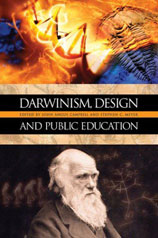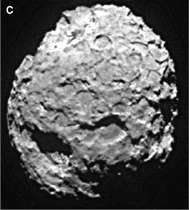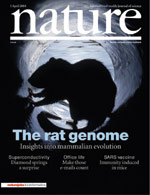COSMIC ANCESTRY | Quick Guide | What'sNEW - Later - Earlier - Index | by Brig Klyce | All Rights Reserved | ||
What'sNEW Archives, April-June 2004Darwinism's ability to produce evolutionary progress has not been demonstrated. I will defend that one. All the rest is simply to counter the claim that there is no other way.17 June 2004
Harold A. Weaver of Johns Hopkins University Applied Physics Laboratory commented, "The cometary dust spectra were dominated by organic, nitrogen-rich material and were completely different from spectra of the interstellar dust particles collected during the cruise phase of the mission. The spectra did not show any evidence for water ice, polyoxymethylene (which had been tentatively identified in mass spectra of comet Halley), or amino acids." Gathering particles in its aerogel and collecting other data, Stardust approached within 236 km of comet Wild 2 on 2 January 2004. Other fascinating observations like landscape features and powerful jets are reported in tomorrow's issue of Science and on NASA's webpages.
3 June 2004
Knockout mice leave ultraconserved regions unexplained. In November 2003 and May 2004, we reported on newly observed genomic elements of unknown function. They have been found in more than a dozen mammalian genomes and are better-conserved than active genes. Many are perfectly conserved. Darwinism holds that sequences so well-conserved must serve some important purpose, and we agree. Now New Scientist reports:
"To find out the function of some of these highly conserved non-protein-coding regions in mammals, Edward Rubin's team at the Lawrence Berkeley National Laboratory in California deleted two huge regions of junk DNA from mice containing nearly 1000 highly conserved sequences shared between human and mice. One of the chunks was 1.6 million DNA bases long, the other one was over 800,000 bases long.
As we wrote last month, "According to cosmic ancestry, advanced eukaryotic genomes must contain high-level software capable of recognizing, installing, assembling and activating horizontally acquired genetic programs. Perhaps the ultraconserved elements are components of such software. In that case, experiments with knockout mice would not easily reveal their functions." [Thanks, Larry Klaes and Stan Franklin.]
3 June 2004
 More animal genes came from bacteria. According to a report coming in the July 2004 issue of Trends in Genetics, genes for enzymes involved in the manufacture of important chemical messengers were transferred from bacteria to animals, perhaps half a billion years ago. The genes are essential for animal functions including learning, memory, mental alertness, sleep patterns, and allergic responses. NIH's website reports:
More animal genes came from bacteria. According to a report coming in the July 2004 issue of Trends in Genetics, genes for enzymes involved in the manufacture of important chemical messengers were transferred from bacteria to animals, perhaps half a billion years ago. The genes are essential for animal functions including learning, memory, mental alertness, sleep patterns, and allergic responses. NIH's website reports:
"For the study, the researchers conducted a comprehensive search of the National Library of Medicine's genetic databases. They identified a group of genes needed to make some enzymes involved in the manufacture of the chemical messengers that cells use to communicate. The genes are present in bacteria and in vertebrate animals, but with a few exceptions, not in plants, or other complex living organisms. The search was prompted by the group's earlier observation that [another] enzyme ...was present in animals, bacteria, and yeast, but in no other living organisms. "It is not known how the genes were transferred, but [a member of the research team, David] Klein theorizes that one form of transfer took place during the reproductive cycle, with the genes having been incorporated into either sperm or egg cells or incorporated shortly after fertilization. It's possible that the transfer could also represent a form of infection where genetic material is transferred into these reproductive cells and thereby into the entire genome of the recipient." According to our reasoning, wholly new genetic programs must be acquired by gene transfer. The new report from NIH adds to the growing list of apparent examples of this process. Examples documenting the darwinian creation of new genetic programs remain few in number and very weak. [Thanks, Newshub.]
1 June 2004
 Darwinism, Design, and Public Education, a new collection of essays, is available in paperback. In the opening essay, co-editor John Angus Campbell explains his purpose: "Why are we still debating Darwinism? Why not teach the controversy?" The volume contains articles by the best-known creationists and intelligent design advocates, as well as many by their traditional darwinist opponents and others. In the "others" category are Brig Klyce and Chandra Wickramasinghe with a five-page article, "Creationism versus Darwinism: A Third Alternative" (p 543-548). Campbell says we "illustrate the pluralism of the design perspective." (But howcome the other creationists hastily dismiss panspermia, if they mention it at all?)
Darwinism, Design, and Public Education, a new collection of essays, is available in paperback. In the opening essay, co-editor John Angus Campbell explains his purpose: "Why are we still debating Darwinism? Why not teach the controversy?" The volume contains articles by the best-known creationists and intelligent design advocates, as well as many by their traditional darwinist opponents and others. In the "others" category are Brig Klyce and Chandra Wickramasinghe with a five-page article, "Creationism versus Darwinism: A Third Alternative" (p 543-548). Campbell says we "illustrate the pluralism of the design perspective." (But howcome the other creationists hastily dismiss panspermia, if they mention it at all?)The darwinist writer Masimo Pigliucci gives panspermia the lengthiest treatment besides ours. Unfortunately, he is misinformed, as when he writes, "the kind of compounds found by astronomers in [interstellar clouds and comets] are very simple..." (p 196). Yet in April 2000, scientists managing the mass spectrometer aboard the Stardust mission announced that most of the interstellar particles they encountered were large, complex organics. Next, after suggesting that only racemic amino acids and sugars are found in meteorites (p 197), Pigliucci corrects this mistake with a too-frank admission: "This particular statement may need to be modified because of recent research showing that cosmic radiation can in fact cause asymmetric chirality without the intervention of living organisms" (note 4, p 205). In other words, he ignores the evidence for excesses of left-handed amino acids in meteorites until he hears of a way to account for them nonbiologically. His most misleading statement is this one: "Meteors continue to bombard our planet... on a regular basis, yet so far not a single living organism or complex organic molecule has been found inside any of them" (p 197). On the contrary, scientists who examine carbonaceous meteorites know that fossilized microorganisms are found in lots of them; and bacteria, sometimes culturable ones, are abundant in the very high atmosphere. How could evidence in favor of panspermia be stronger? Alas, Pigliucci's mindset is evident from the start, when he says that Fred Hoyle's panspermia lies outside science's realm (p 195). Although some of the other essays make passing reference to panspermia, none considers it seriously. But we thank Campbell for our opportunity to present a third alternative to this controversy's audience.
27 May 2004
 Organics in planet-forming discs. Using the Spitzer Space Telescope NASA sees "significant amounts of icy organic materials sprinkled throughout several... dusty planet-forming discs, which circle infant stars." (See artist's illustration.) "These materials, icy dust particles coated with water, methanol and carbon dioxide, may help explain the origin of icy planetoids like comets. Scientists believe these comets may have endowed Earth with some of its water and many of its biogenic, life-enabling materials. ...Previous studies identified similar organic materials in space, but this is the first time they were seen unambiguously in the dust making up planet- forming discs." Pseudo-panspermia — the delivery of "prebiotic compounds" from space — is clearly in the mainstream now.
Organics in planet-forming discs. Using the Spitzer Space Telescope NASA sees "significant amounts of icy organic materials sprinkled throughout several... dusty planet-forming discs, which circle infant stars." (See artist's illustration.) "These materials, icy dust particles coated with water, methanol and carbon dioxide, may help explain the origin of icy planetoids like comets. Scientists believe these comets may have endowed Earth with some of its water and many of its biogenic, life-enabling materials. ...Previous studies identified similar organic materials in space, but this is the first time they were seen unambiguously in the dust making up planet- forming discs." Pseudo-panspermia — the delivery of "prebiotic compounds" from space — is clearly in the mainstream now.27 May 2004
Microbes have stolen some of our genes! Over the past decade, in an unannounced paradigm shift, the orthodoxy has become this: bacteria acquire new traits by acquiring genes, via phages, or directly from other bacteria. Now, malaria researchers at the European Molecular Biology Laboratory in Heidelberg report, "Bacteria have stolen a key defensive gene from the very animals that they are invading — and are now using it against them." [Thanks, Jim Galasyn.]
7 May 2004
Ultraconserved elements — A newly observed class of genomic elements of unknown function are 100% conserved, with no insertions or deletions, among the human, rat and mouse genomes. There are over 5,000 such segments longer than 100 base-pairs, and 481 longer than 200 bp. Many of them are also present in the chicken and dog genomes, at 95% and 99% identity, respectively. Many of them are also found in fish. They are widely distributed across the human genome, sometimes overlapping with the exons of genes for RNA processing, sometimes in introns or near regulatory genes, and sometimes far from any gene. The international team who discovered them calls the 481 longest ones "ultraconserved elements."
In cosmic ancestry, new genetic programs must originally be imported into a species. If so, genomic comparisons should find that those programs, or the major pieces of them, are either present in very similar form, or altogether absent, as one looks deeper into the past. The new study finds that only 5%, or 24 of the 481 ultraconserved elements have orthologs in the genomes of the two sequenced eukaryotic nonvertebrates, fruitflies and soil nematodes. We think the facts support CA's accounting for the emergence of new genetic programs. [Thanks, NewsHub and Jim Galasyn.]
6 May 2004
...Great revolutionary advances in science always will sound crazy at the beginning.
5 May 2004
 Viruses old as life? When virologists analyzed a hyperthermophilic virus from an archaeal host living in a Yellowstone hot spring, they found "astounding" conformational relationships linking it to known viruses of bacteria and animals. They conclude, "some viruses may have a common ancestor that precedes the division into three domains of life > 3 billion years ago."
Viruses old as life? When virologists analyzed a hyperthermophilic virus from an archaeal host living in a Yellowstone hot spring, they found "astounding" conformational relationships linking it to known viruses of bacteria and animals. They conclude, "some viruses may have a common ancestor that precedes the division into three domains of life > 3 billion years ago."26 April 2004
Thanks, SETI League, for naming Cosmic Ancestry as this month's "SETI SuperStar Site".24 April 2004
19 April 2004
Mars may have life today. That's the opinion of an evolutionary biologist at Imperial College in London, writing in today's New York Times. "Perhaps the strongest reason to think the planet could be home to something is that over the past 20 years, we've learned that many inhabitants of Earth live in environments as peculiar as those on Mars," she writes. Whereas some 90 pounds of Mars material per year reaches Earth in the form of meteorites, she thinks, "bringing Martian rocks back to Earth... could be a mistake if not undertaken very carefully." NASA agrees and is planning a high-security containment facility for the samples. We're glad that the possibility of life on Mars is becoming broadly recognized.17 April 2004
In biology all things must be proved several times.16 April 2004
The rat genome has been sequenced. In the writeup by the Rat Genome Sequencing Project Consortium in Nature, several points interested us:
"Some genes found in rat, but not mouse, arose through expansion of gene families. These include genes producing pheromones, or involved in immunity, chemosensation, detoxification or proteolysis." These genes apparently arose by gene duplication and they serve basically the same functions as the genes from which they were duplicated. They differ because their protein products recognize slightly different targets. A duplicated gene may adapt like that by exploring a tiny neighboring sequence space. This possibility does not mean that gene duplication can produce a wholly new function. For that, a gene would have to traverse a much vaster, unrestricted sequence space. Wouldn't its chance of success, in 12-24 million years, be just as small as the Consortium estimates above? Slightly more than nine percent of the rat genome consists of long terminal repeat (LTR) elements, all of which "are endogenous retroviruses (ERVs) or their non-autonomous derivatives." Rats, like humans, have more viruses than genes in their genomes. The opportunity for eukaryotes, including mammals, to acquire genes transferred by viruses is undeniable. A portion comprising 5-6% of the genome, shared among rats, mice and humans, is highly conserved, apparently under purifying selection. In that portion "noncoding regions outnumber coding regions regardless of the strength of the constraint." This finding reinforces an earlier study of "Conserved Non-Genic Sequences," reported here 20 November 2003. It suggests to us that these genomes also contain high-level software such as they would need, if new genetic programs must be horizontally transferred and properly installed during evolution.
14 April 2004
 "Can we ever hope to pin down the genetic changes that underlie the big steps in evolution? Possibly so, if a study of the variation in the pelvic fins of sticklebacks is anything to go by." These sentences are the promotional lead-in to Neil Shubin and Randall Dahn's commentary on a genetic study in Nature by an international, interdisciplinary team. Sounds like the darwinian paradigm is getting another ringing confirmation, right?
"Can we ever hope to pin down the genetic changes that underlie the big steps in evolution? Possibly so, if a study of the variation in the pelvic fins of sticklebacks is anything to go by." These sentences are the promotional lead-in to Neil Shubin and Randall Dahn's commentary on a genetic study in Nature by an international, interdisciplinary team. Sounds like the darwinian paradigm is getting another ringing confirmation, right?
In the smaller text that follows, the big steps are described as genetic variation, and anatomic and behavioral distinctions. Turns out, this study is about "the genetic basis for ...limb reduction in threespine stickleback fish" — a loss of function, in other words. Sure, it's interesting that regulatory changes in Pitx1 expression can remove spines from fish and even reduce hindlegs in mice. But the layman's "big steps in evolution" are not signified by lost features, but by the emergence of wholly new features. This study is not about them, so the commentary's bold print — intentionally or not — will mislead most people. Accounts in support of darwinism too often include exaggerations like this one.
2 April 2004
 ESA detects methane on Mars. The Planetary Fourier Spectrometer (PFS) on the Mars Express has seen very small amounts of methane, "about 10 parts in a thousand million," in Mars' atmosphere. The result reinforces an earlier finding by Michael Mumma of NASA's Goddard Space Flight Center, reported in September 2003. And this month, a team led by Vladimir Krasnopolsky of Catholic University will report finding a single spectral line for methane on Mars using the Canada-France-Hawaii telescope.
ESA detects methane on Mars. The Planetary Fourier Spectrometer (PFS) on the Mars Express has seen very small amounts of methane, "about 10 parts in a thousand million," in Mars' atmosphere. The result reinforces an earlier finding by Michael Mumma of NASA's Goddard Space Flight Center, reported in September 2003. And this month, a team led by Vladimir Krasnopolsky of Catholic University will report finding a single spectral line for methane on Mars using the Canada-France-Hawaii telescope.
No methane at all would survive in Mars' atmosphere for more than a few hundred years unless something kept supplying it. On Earth, methanogenic bacteria do this task. NASA's Everett Gibson has said, "If we detect the presence of methane, it could be a very powerful indicator that there may be biological processes operating on Mars." [Thanks, Jerry Chancellor.]
| ||
COSMIC ANCESTRY | Quick Guide | What'sNEW - Later - Earlier - Index | by Brig Klyce | All Rights Reserved |

 "The researchers expected the mice to exhibit various problems as a result of the deletions. Yet the mice were virtually indistinguishable from normal mice in every characteristic they measured, including growth, metabolic functions, lifespan and overall development. 'We were quite amazed,' says Rubin, who presented the findings at a recent meeting [The Biology of Genomes, 12-16 May 2004] at Cold Spring Harbor Laboratory in New York."
"The researchers expected the mice to exhibit various problems as a result of the deletions. Yet the mice were virtually indistinguishable from normal mice in every characteristic they measured, including growth, metabolic functions, lifespan and overall development. 'We were quite amazed,' says Rubin, who presented the findings at a recent meeting [The Biology of Genomes, 12-16 May 2004] at Cold Spring Harbor Laboratory in New York."
 Most of them show no evidence for transciption in any studied species. If they were subject to unconstrained neutral substitution at the slowest observed rate, the chance of finding even one in the human genome would be less than 10^-22. This means that purifying natural selection (or something else) must have protected them as they performed specific functions for the past 300-400 million years. What might those functions be? Experiments with "knockout mice" could reveal elements that regulate the development process, for example. But what about other non-protein functions? We note that, according to cosmic ancestry, advanced eukaryotic genomes must contain high-level software capable of recognizing, installing, assembling and activating horizontally acquired genetic programs. Perhaps the ultraconserved elements are components of such software. In that case, experiments with knockout mice would not easily reveal their functions.
Most of them show no evidence for transciption in any studied species. If they were subject to unconstrained neutral substitution at the slowest observed rate, the chance of finding even one in the human genome would be less than 10^-22. This means that purifying natural selection (or something else) must have protected them as they performed specific functions for the past 300-400 million years. What might those functions be? Experiments with "knockout mice" could reveal elements that regulate the development process, for example. But what about other non-protein functions? We note that, according to cosmic ancestry, advanced eukaryotic genomes must contain high-level software capable of recognizing, installing, assembling and activating horizontally acquired genetic programs. Perhaps the ultraconserved elements are components of such software. In that case, experiments with knockout mice would not easily reveal their functions.




 "...There were no compelling data showing rat-specific genes arising directly from non-coding sequences...." Moreover, "The paucity of rodent-specific genes indicates that de novo invention of complete genes in rodents is rare. This is not unexpected, because the majority of eukaryotic protein-coding genes are modular structures containing coding and non-coding exons, splicing signals and regulatory sequences, and the chances of independent evolution and successful assembly of these elements into a functional gene are small, given the relatively short evolutionary time [12-24 million years] available since the mouse-rat split." We would like to know what length of time is needed to make the "chances of independent evolution" not small. Heretofore, according to darwinism, that method was the primary one.
"...There were no compelling data showing rat-specific genes arising directly from non-coding sequences...." Moreover, "The paucity of rodent-specific genes indicates that de novo invention of complete genes in rodents is rare. This is not unexpected, because the majority of eukaryotic protein-coding genes are modular structures containing coding and non-coding exons, splicing signals and regulatory sequences, and the chances of independent evolution and successful assembly of these elements into a functional gene are small, given the relatively short evolutionary time [12-24 million years] available since the mouse-rat split." We would like to know what length of time is needed to make the "chances of independent evolution" not small. Heretofore, according to darwinism, that method was the primary one.